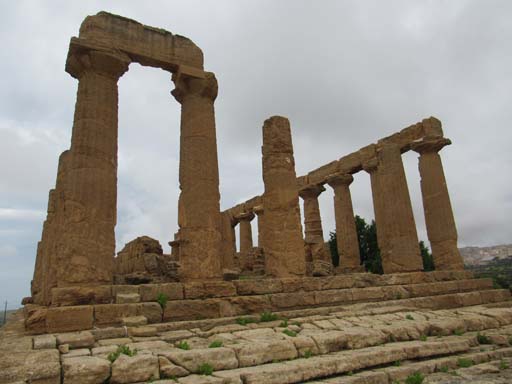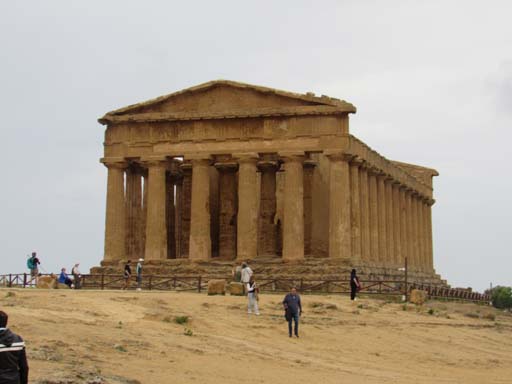Leaving the Bougainville in the harbor of Porto Empedocle, we headed up the hill to Agrigento, which in its heyday was known as Akragas, after one of the rivers that ran past the town. In Akragas’ glory years in the 5th Century BCE, the city gobbled its neighbors, controlled the middle section of Sicily, held the Carthaginians at bay thanks to an alliance with Syracuse, and was stinking rich. It was one of the leading cities of Greater Greece, the Greek-settled areas of Sicily and southern Italy. According to Plato, the inhabitants “build like they intend to live forever, yet eat like this is their last day.”
The day was cloudy and cool, and rain drizzled down on the ruins. Because of my injured knee I walked with a slow-moving group made of people with mobility issues. This was fine— there were so few of us that we could hear our guide without needing to use amplification, and we saw the same things the larger groups did.
The city was on a couple defensible ridges, and below in a “valley” (actually a lower ridge) they built a spectacular series of eight temples to their gods. This was clearly a power move, since the temples would have been visible far out to sea, and were situated to amaze any travelers climbing up from the port. We’re rich and mighty, the temples say, and the gods are entirely on our side.
Other than this, everything we know about the temples is wrong.
The descriptions we have of the temples comes from a medieval translation of an ancient source, and in recent years it’s been discovered that the translation was poor, and that the original passage was describing another city entirely. (Another city with eight temples in a valley below the town, apparently.)
People had believed for ages that they knew which temple belonged to which god, and now they don’t. The “Temple of Hera” in the photo above has no inscriptions to identify who it actually belongs to, though archaeologists have recently unearthed some small statues of Athena. So maybe Ox-eyed Hera must give precedence to the Aegis-Bearer.
To defend the temple mount the Akragans built a wall– or rather excavated it. Rather than top the ridge with masonry or stone, they hacked their wall out of the living rock. Which basically meant they lowered the ridge by about thirty feet while leaving a rock rampart all the way around it. Presumably this also created a nice flat space to build temples on, but it still speaks to the amount of labor Akragas had available. They must have had colossal numbers of slaves from the enemy armies defeated and the towns taken.
This is the Temple Formerly Known as Concordia. It’s no longer known which god was once in residence. This is by far the best preserved temple, which survived because it became a Christian church. You can see the church built inside the colonnade, the god’s sanctuary enlarged and altered to hold a congregation. (Worshippers in the classical period did their worshipping from outside, not in the building.)
The Parthenon of Athens also survived because they put a cross on it, as did practically every temple that remained intact— though I recall a temple in Provence that is in fine shape because it’s where the city council meets.
Note that both temples are of the Doric order. All Greek-style temples in Sicily are in the Doric style, because by the time the other orders became fashionable the people of Magna Graecia had stopped building temples. Money was harder to come by, and the Romans were stepping in and taking over.
The other six temples are ruined by time and Poseidon Earthshaker. One British gentleman bought a country house on the ridge top, and restored a few columns of the alleged Temple of Ares, but the rest were toppled by earthquakes and never rebuilt. The largest Doric temple ever built, the Temple of Zeus, was never completed due to the Carthaginians sacking the city, and was then used as a quarry by people from the town, and to build the jetties in Porto Empedocle.
After being sacked during the First Punic War, the fortunes of Akragas waned, and then the Romans took the place and enslaved the entire population. It was fought over for some time, but when the Roman Peace began the city began again to thrive.
The port is named after Empedocles, the pre-socratic philosopher who invented the theory of the Four Elements. According to one tradition Empedocles committed suicide by throwing himself into Mount Etna, which became the subject of a dramatic poem by Matthew Arnold that I had to slog through in school.
I say: Fear not!
Life still leaves human effort scope.
But, since life teems with ill,
Nurse no extravagant hope;
Because thou must not dream, thou need’st not then despair!
Cheerful, what?


Hi Walter. Haunting imagery.
I love the iconography on the coinage of Akragas, particularly the masterfully engraved tetradrachmae.
Here’s an example:
https://www.cngcoins.com/Coin.aspx?CoinID=126568
“Empedocles at Etna” reminded me of this fragment from Hesiod (the aftermath of the Pandora episode):
“Full is the earth of ills, and full no less are the waters”
I know your trip was unfortunately cut short (my sympathies!)—were you able to visit the Villa Romana del Casale?
That has long been on my list, but perhaps too far inland for your itinerary.
Comments on this entry are closed.